Film of the Week: The Green Fog
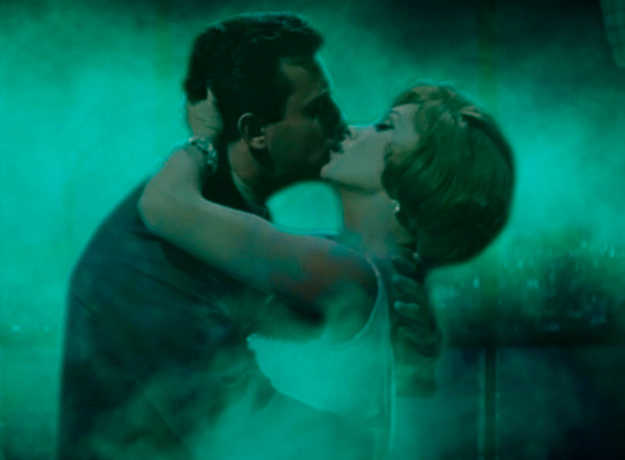
The Green Fog is a new version, in a wonderfully oblique fashion, of Hitchcock’s Vertigo; it could also have been named San Francisco Plays Itself or, to borrow a title from Peter Greenaway, Vertical Features Remake. Hitchcock’s film is one of the most vertically obsessed films ever and The Green Fog follows suit, but since this is a work co-directed by Guy Maddin, you can imagine that it’s also obsessive on many other levels that Hitchcock could never have dreamed of.
It’s hard to know just what to compare this hour-long fantasia to, except perhaps to Christian Marclay’s legendary 24-hour collage piece The Clock (2010), in which the minutes and hours of the day are marked out in sampled fragments from countless films. For Marclay, the essential reason for using a particular image is that it denotes a specific moment of the day; for Maddin and his co-directors, brothers Evan and Galen Johnson, each clip is valuable in that it can stand in for a moment of Hitchcock’s film (unless it simply gives us a chance to marvel at the impassive horse-like physiognomy of Chuck Norris, in which case it’s in anyway).
One can situate The Green Fog at the center of a recondite Venn diagram of “Cinema as Art.” It marks the intersection of two sets: Moving Image Art Inspired by Hitchcock (most famously, Douglas Gordon’s 24-Hour Psycho), and Bizarre Conceptual Remakes (the latter containing Wade Williams’s 1992 shot-by-shot recreation of Detour). In fact, there’s already some overlap on the diagram, with at least two more or less shot-by-shot Hitchcock remakes already extant: Remake, French artist Pierre Huyghe’s studiedly drab 1995 take on Rear Window; and Gus Van Sant’s studio-financed yet deliriously recondite Psycho (1998). Maddinites won’t be surprised to know that The Green Fog is more fun to watch than all of these put together.
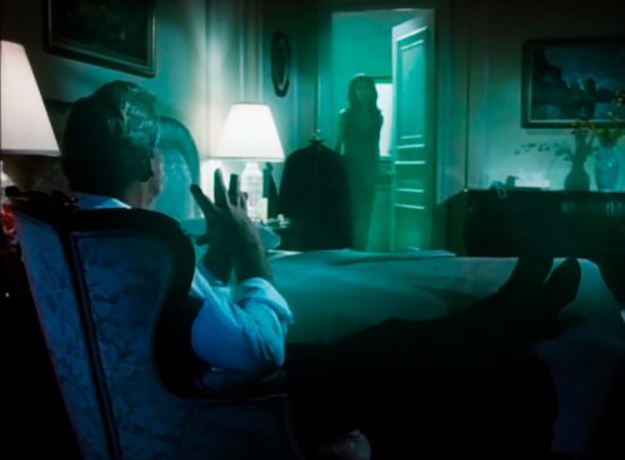
Described as an “ode” to Vertigo, The Green Fog starts out from two ideas. One is the strangest image in Hitchcock’s film: the bizarre neon-emerald miasma that envelops Kim Novak’s Judy when she steps out of the hotel bathroom, transfigured in front of Scottie’s erotically bedazzled gaze. The other is the way that Vertigo obsessively maps the city of San Francisco—its streets, its stretches of water, its dizzy heights, its sheer drops. The Green Fog tells a story of sorts, essentially reproducing the shape of Vertigo—with some room for facetiously digressive play—using clips from assorted films and TV series, all shot on location in San Francisco, to stand in for moments of Hitchcock’s film. The Green Fog’s end credit sequence, a breakneck inventory of those titles, is one of the highlights. It lists 100 titles, some exalted (The Conversation, The Lady From Shanghai, Vertigo itself), some less so (Alfred Zugsmith’s Confessions of an Opium Eater, So I Married an Axe Murderer), and some proudly obscure (Lina Wertmüller’s The End of the World in Our Usual Bed in a Night Full of Rain, Nobuhiko Obayashi’s Take Me Away!, and something called Eiskalte Leidenschaft, which turns out to be the German release title of Final Analysis).
Since some of the sources are TV series—Mission Impossible, Murder She Wrote and, of course, The Streets of San Francisco—you can bet that Maddin and the Johnsons have taken advantage of as many separate episodes as they can (Rock Hudson appears at various ages in different episodes of McMillan and Wife). Many of the choices seem all but arbitrary, but others are totemic: what better film to stand in for Vertigo, as a Frisco epic of traumatic verticality, than The Towering Inferno? To a large degree, The Green Fog is Hitchcock’s film reconfigured, not illogically, as a disaster movie. Similarly iconic, as an encyclopedic venture in policier psychogeography, is The Streets of San Francisco, which provides locations a-go-go and Karl Malden as a perfect investigative stand-in for James Stewart.
In the story of sorts that unravels, Novak and Stewart are played variously by Faye Dunaway, Susan Saint James, Gina Lollobrigida, Anthony Franciosa, Dean Martin, a whole sprawling cast of actors who sometimes look nothing like the original, sometimes resemble them strangely (it’s amazing how Novakian Doris Day looks, when she’s wearing the right hairdo). As one actor turns into another several times in a single sequence, and yet some kind of narrative coherence persists, the effect is like listening to a symphony created by cut-and-splice from a hundred different recordings (rather like John Oswald’s Greyfolded, collaged from multiple versions of the Grateful Dead’s “Dark Star”). The basic “melody” continues to be recognizable as Vertigo, although the orchestrations and even the individual instruments change every few seconds.
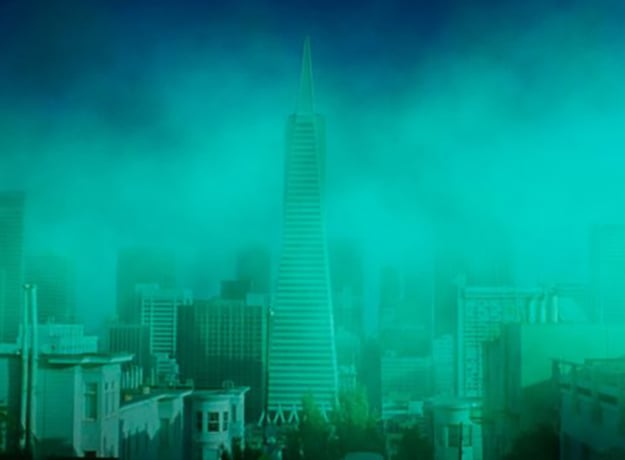
Individual sequences are recognizable as narratively or thematically close to Hitchcock. There’s a passage featuring women (or, in one case, identical twin schoolgirls) looking at portraits, echoing Madeleine/Judy as she studies the mysterious likeness of Carlotta Valdez; a whole series of arduous climbs; and a car chase in which a red saloon becomes a white Rolls Royce, then a sports coupé… In an uproarious recreation of the opening rooftop pursuit—featuring, I think, the fateful metal rung from Vertigo itself—it’s not James Stewart who appears over the parapet but Chuck Norris, after which the screen is filled with a whole succession of cops and criminals, runners and jumpers, culminating in Vincent Price teetering in perilous slo-mo on the edge of a parapet.
Far from observing slavish shot-for-shot substitution, The Green Fog impishly expands the limits of its brief. A wonderfully poetic, supernatural-seeming prologue gives us San Francisco at night, cloaked in dense swirling green; a Chinese woman walks alone, a man creeps in slow motion amid eerily empty streets. The film is also an extended conceptual joke about cinema and the obsessive watching that is Vertigo’s subject. That opening “haunted city” sequence is actually framed by Rock Hudson watching a screen on which a finger points to San Francisco on a map. The Green Fog repeatedly takes us back to Hudson in front of one screen or another, and sometimes to screens within screens—as when Norris appears to be watching Hudson watching Anthony Quinn (in 1960’s Portrait in Black, with Sandra Dee as the Novak near-lookalike). At one point, Hudson chuckles as the movie he’s watching catches in the projector: “That’s the trouble with that old film.” Elsewhere, he and his assistants seem to be standing in for Maddin and the Johnsons as they source material for The Green Fog: “What are we looking for, sir?” says a tape op, scanning footage. Rock replies, “I don’t know, but at this point I’ll take anything.” The next image illustrates that “whatever works” principle perfectly: as substitute for the famous sequoia sequence, we get an NSYNC music video shot in a forest (Justin Timberlake, get it?).
As befits the Maddin imagination, The Green Fog is constructed with an eye for the bizarre and the joyously perverse. Discontinuity is sometimes wildly heightened, in classic Surrealist mode. Joseph Cotten, seated on a roof terrace surrounded by roses, peers down into the street below, sees something (cut to a swooping overhead shot) and appears to react with curiosity, then looks again and sees something in the sky (cut to a shot from below). Each time the look on Cotten’s face is inexplicably priceless, as if responding to a wildly bizarre apparition, or just an outré private joke. Somehow, this sequence perfectly distills the revelatory strangeness of the apartment scenes in Un Chien Andalou, but it’s also Kuleshov Effect 101 taken to the craziest, silliest limit.
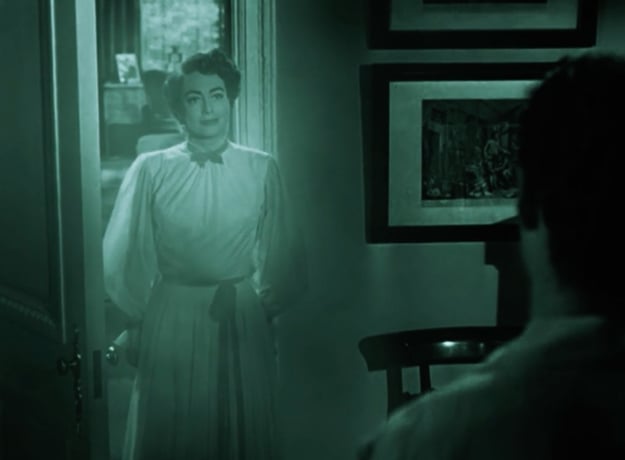
Throughout, The Green Fog does wonderful things with faces: it mostly shreds out the dialogue from a given scene to retain only the moments in between, edited with a juddery hiccupping rhythm as in the re-spliced films of Martin Arnold. Take the montage of deranged snarls from John Saxon, or the lunch between two middle-aged men, apparently in a 1980s TV episode: their wordless moues, raised eyebrows and stifled grunts suggest cautious gay flirtation, especially given the cutaways to panoplies of cocktail sausages, apparently filmed a decade earlier. There’s a female counterpart to this scene, when Virginia Gray (Portrait in Black) goes to a bar, and promptly turns into another actress in what appears to be a prolonged, almost wordless lesbian tryst. (Sometimes Hitchcock’s doppelgänger theme plays out through the multiple use of actors: we first see Gary resembling a much older Novak in 1960, but we also glimpse her much younger self in 1945’s Flame of Barbary Coast; other doubles, like older and younger John Saxons and Michael Douglases, recur throughout).
Words don’t vanish altogether: in places, dialogue is retained but practically drowned out by raging wind, or muffled by protective suits and visors. Sometimes Maddin and company just throw a well-placed line into the mix. Example: Michael Douglas’s bare ass in Basic Instinct is replaced by that of a naked man in a fragment of Eadweard Muybridge’s pioneering capture of human motion; cut to a much younger Douglas in The Streets of San Francisco narcissistically ogling the spectacle: “Boy, you look good Mike.” Elsewhere, an extended sequence, standing in for Scottie’s and Judy’s showdown, splices together umpteen different couples, the accelerating ping-pong of shouted accusations becoming increasingly incoherent as the dialogue overlaps; it’s all accompanied by frenzied ostinato strings from the Kronos Quartet, playing Jacob Garchik’s score (mesmerizing, intermittent and only sometimes overtly Hermann-esque).
As for the green fog itself, its hue surreptitiously leaks in when least expected, from Sandra Dee’s dress to a long hospital corridor. The fog itself makes surprise appearances, through digital retouching: a man pours beer on a grave and a little wisp of green smoke rises; a florist shows Malden a card that contains the swirling vapor in hologram form. Soon after Judy—played here by Joan Crawford—appears bathed in that exotic aura, fog starts billowing, generated by a passionate kiss, till it starts creeping under hotel doors and up corridors, soon enveloping the city itself. Yes, the fog is love, death, mystery, Scottie’s morbid desire; but it’s also the combustibility of old film stock and of memory. The Great San Francisco Fire that breaks out here is caused not by Mrs. O’Leary’s mythical cow, but—wouldn’t you know it?—by someone watching a movie.
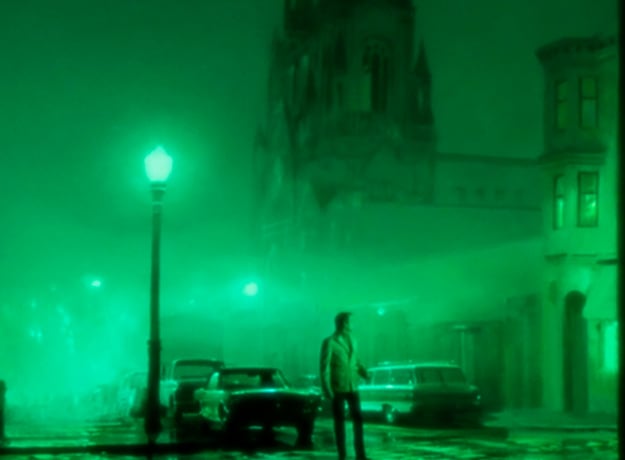
The volatility of cinema was a theme of a previous Maddin-Johnson collaboration—2015’s The Forbidden Room (directed by Maddin and Evan, design and music by Galen), an assemblage of arcane stories morphing into other stories in which the imagery seemed to exist in a constant state of bubbling, morphing deliquescence. That feature was composed of imagery shot for the Seances project (now viewable online), in which Maddin imaginatively recreated a catalog of lost, forgotten or sometimes never-existent films from the past. That was an attempt to bring films back from the dead; The Green Fog is different, but related in spirit. It’s more of a Frankenstein project, reassembling the body of Vertigo from a multiplicity of borrowed parts, each of which has a rebellious spirit of its own and only consents to be incorporated up to a point, each continuing to twitch with its own autonomous energy. This is an exuberant, celebratory, often marvelously funny piece of work; it’s also strangely melancholic and mesmerizingly uncanny, as that eerie prologue sequence promises. If Vertigo was the story of a ghost, The Green Fog, you might say, is the ghost of a story.
Jonathan Romney is a contributing editor to Film Comment and writes its Film of the Week column. He is a member of the London Film Critics Circle.







